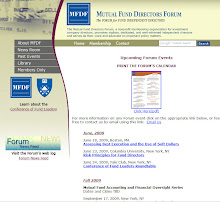Market participants relied on the thriving securitization process to disperse risk and provide more private capital raising and investing opportunities for investors, but as we have learned that process did not eliminate or, in many cases, even reduce risk. Ultimately, the growing size and dispersion of risk, combined with deteriorating markets, has made clear to regulators the need for greater transparency and stronger risk management controls for financial institutions of all kinds.Sirri also discussed the consolidated supervised entity, or CSE program, overseen by the SEC and FINRA, and some of the components and mechanics that had been implemented to provide oversight over five large U.S. securities firms, Goldman Sachs, Merrill Lynch, Morgan Stanley, Lehman Brothers, and Bear Stearns. The main thrust of Sirri's testimony, however, was a discussion of observations and lessons learned from the recent global market crisis, and the challenges ahead in formulating a revised regulatory regime.
The Bear Stearns and Lehman Brothers' experience as well as the continuing financial distress and government support of commercial banks and insurance companies has challenged a number of assumptions held by the SEC. We are working with other regulators to ensure that the proper lessons are derived from these experiences, and changes will continue to be made to the relevant regulatory processes to reflect those lessons.
Among the lessons Sirri listed were:
- One lesson from the SEC's oversight of CSEs — Bear Stearns in particular — is that no parent company liquidity pool can withstand a "run on the bank." Supervisors simply did not anticipate that a run-on-the-bank was indeed a real possibility for a well-capitalized securities firm with high quality assets to fund.
- For financial institutions that rely on secured and unsecured funding for their business model, some modification, such as government backstop emergency liquidity support, may well be necessary to plug a liquidity gap on an interim basis, to guarantee assets over the longer term, or to provide a capital infusion. Indeed, as we have seen, such facilities can be necessary even for deposit-taking institutions. The role of the government in providing any such backstop liquidity should be carefully circumscribed, and the effects on incentives considered.
- Another lesson relates to the need for supervisory focus on the concentration of illiquid assets held by financial firms, particularly in entities other than a U.S. registered broker-dealer. Such monitoring is relatively straightforward with U.S. registered broker-dealers, which must disclose illiquid assets on a monthly basis in financial reports filed with their regulators. Also, registered U.S. broker-dealers must take capital charges on illiquid assets when computing net capital. As a result, illiquid assets often are held outside the registered U.S. broker-dealer in other legal entities within the consolidated entity. So, for the consolidated entity, supervisors must be well acquainted with the quality of assets on a group wide basis, monitor the amount of illiquid assets, and drill down on the relative quality of such illiquid assets.
- While the SEC knew the importance of supervisory focus on illiquid assets, I do not believe any regulator truly understood that market perception of the integrity of the financial statements, which involves both the amount of illiquid assets and the valuation of such assets, could erode so precipitously and ignite a run on a securities firm.
- Another important lesson is that critical financial and risk management controls cannot just exist on paper. They must be staffed appropriately and well-resourced.
- Firm boards of directors must participate actively in setting the risk appetite of the firm, hold senior management accountable for following the board's direction on risk taking, and force management to take action, as appropriate.
He also addressed the challenges the various securities regulators, including the SEC, face in formulating changes to their regulatory regimes, particularly in a global market.
Having learned all of these lessons, we at the SEC are focusing on how best to deploy our broker-dealer expertise in a new regulatory paradigm. As Congress considers the financial services regulatory structure, we believe that regulatory expertise should be recognized and deployed efficiently.
. . .The full text of Erik Sirri's March 18 testimony is available at: http://sec.gov/news/testimony/2009/ts031809es.htm
Given the recent dialogue about systemic regulation, I must note that our experience with the bankruptcy filing of a foreign affiliate of Lehman Brothers has demonstrated the innate difficulties of any multijurisdictional approach to regulation. While cross border coordination and dialogue is important, jurisdictions nonetheless have unique bankruptcy and financial regulatory regimes-and creditors wherever they are located shall always act in their own interest during a crisis. Thus, a U.S. liquidity provider might be faced with the difficult choice of guaranteeing the assets of the holding company globally, or else risk creditors exercising their rights against foreign affiliates or foreign supervisors acting to protect the regulated subsidiaries in their jurisdictions, either of which could trigger bankruptcy of the holding company. These are thorny issues that Congress should consider carefully.





